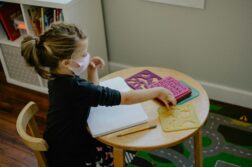
“CAN I HAVE a purse?” I asked Big Mama. I was five years old.
After asking me why I wanted it, my big mama purchased me one. I wore my purse with confidence and pride—in the house. I was never instructed to wear it only in the house, but I sensed that it was our little secret and I kept it as such.
Over the next few months, I pranced around putting anything and everything into my purse, just as I’d seen my mom and big mama do. It was my introduction to womanhood, and it brought me such joy. My joy would come to an end whenever I heard the rattling of house keys, which meant my dad had arrived to pick me up.
And back to reality I went. I would put back on my masculine mask and enter the world of boyhood as if nothing ever happened. I did this for years, wearing my mom’s clothes and shoes, wrapping a towel around my head to give me the illusion of long flowy hair, and imagining myself as the woman I was born to be. Pretending behind closed doors was the only time I was allowed to truly be myself, because in the “boyhood” world of sports, I did everything I could to fit into the box I was supposedly born into. But whispers began to linger in the air, and “sissy” and “soft” were terms that began to be associated with me.
Knowing what my teammates, parents, and family thought of me, I worked on perfecting my craft as a basketball and baseball player, so I could be known for being more than a sissy. Athleticism was my way of deflecting and changing my image. When that didn’t work, humor became my armor. But humor could only suppress my emotions for only so long. On the inside, I was crying out to live my truth, but the world did not allow this.
A Black boy feeling like a woman and wanting to live as one: where was this acceptable? Definitely not in my world, and I didn’t have the language to properly express who I was. The only trans representation I had came from Jerry Springer, who did more to exploit trans women than to humanize them.
It wasn’t until I read Janet Mock’s article “I was Born a Boy” that I finally felt I had a place. Reading writer, director, and advocate Janet Mock discuss her upbringing, her sense of being born in the wrong body, her struggle for self-acceptance, the challenges she faced, and the steps she took to live in her truth, I knew I’d found my counterpart. I’d found a woman whose story paralleled my onw. I, too, dreamed of being a journalist living in the city, writing pieces that moved people. Janet Mock breathed life into me as a trans woman who lived a normal life, a powerful counterweight to the depiction of the ladies on Jerry Springer as “freaks” and “female impersonators.” I immediately began learning more about Janet Mock’s story, and in doing so I came across Isis King, Carmen Carrera, and Candis Cayne—all women like me.
Seeing them allowed me to envision myself as I’ve always wanted to be: a woman living the American dream. But this vision became blurry when reality sank in. How was I going to tell my homophobic family that I was transgender? Although my family wasn’t visibly homophobic, they definitely made jokes that made me uncomfortable. Plus, I didn’t think they’d comprehend the difference between gender and sexuality. It’s a debate that much of the world has yet to grasp.
Still, the more research I did, the more I felt I belonged. I went into a deep dive listening to interviews of my trans sisters telling their stories of heartache and acceptance. I smiled with joy knowing that one day I too would feel this whole as myself. With that joy came pain, though. The murder rate for Black transgender women began to skyrocket, pushing me back into hiding out of fear for my safety.
I already have to deal with being Black in America and the risk that comes with that, but the vulnerability of being Black and trans is even greater. Facing all of this discrimination and hatred, I became depressed and questioned if living my truth was worth possibly losing my life. Thankfully, I spoke to a therapist who helped me win my battle against depression and accept myself for who I am, for better or worse. I took my first hormone replacement shot on August 14, 2016 and never looked back.
While things were looking up, I still hadn’t informed my family, both because I didn’t feel the need and because straight and cisgender people never have to come out as such, so why should I? I was in no rush to have that conversation with my parents. But eventually I decided to tell them I was trans. For a year, I would set a date to come out, the date would come and go, and I’d rinse and repeat.
Finally, in the spring of 2017, I wrote a letter to my big mama where I expressed my love and told her I was transgender. As I placed the letter on her nightstand, my heart pounded with negative thoughts and the fear that this would be the end to our relationship.
Later that night, Big Mama called. “I already knew. I was just waiting for you to accept yourself. And know that nothing would stop me from loving you.” As I cried on the phone, I felt a weight lifted off my shoulders. I felt free.
It took me sixteen years to accept that I was a woman, and while it took my parents longer than Big Mama to accept me, they eventually did so. I came out just in time to walk across the stage as an out trans college graduate, and as I did, I knew I was walking into my destiny as my truest self.
 Chenoa Rai (she/her) a freelance journalist from San Francisco, CA. A proud transgender woman, she loves live-tweeting, watching salacious reality shows, and attending and viewing comedy shows. Most of all she loves getting lost in romance novels. You can follow her on Twitter.
Chenoa Rai (she/her) a freelance journalist from San Francisco, CA. A proud transgender woman, she loves live-tweeting, watching salacious reality shows, and attending and viewing comedy shows. Most of all she loves getting lost in romance novels. You can follow her on Twitter.





